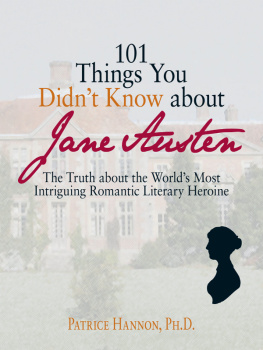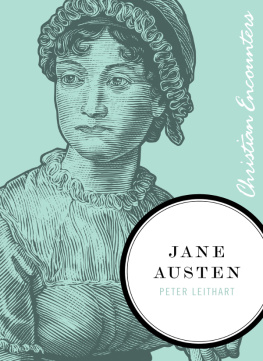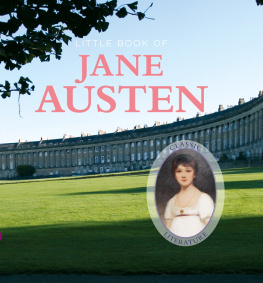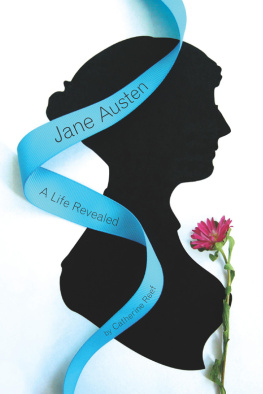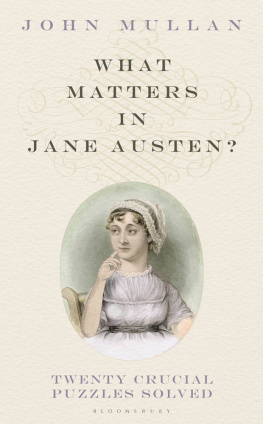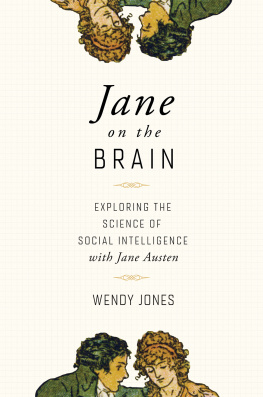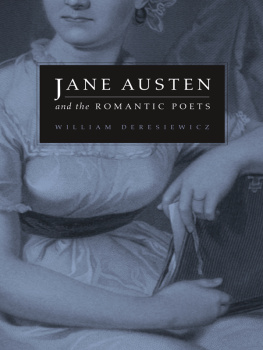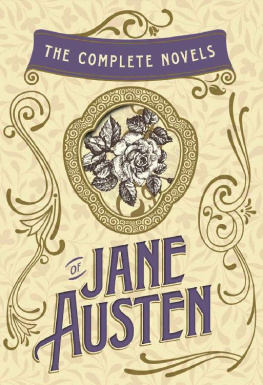THINGS
YOU DIDNT
KNOW ABOUT

The Truth about the Worlds Most Intriguing
Romantic Literary Heroine
PATRICE HANNON, Ph.D.

Copyright 2007, F+W Publications, Inc.
All rights reserved.
This book, or parts thereof, may not be reproduced in any
form without permission from the publisher; exceptions
are made for brief excerpts used in published reviews.
Published by Adams Media, an F+W Publications
Company 57 Littlefield Street, Avon, MA 02322
www.adamsmedia.com.
ISBN 10: 1-59869-284-4
ISBN 13: 978-1-59869-284-6
eISBN: 978-1-44051-712-9
Printed in Canada.
J I H G F E D C B A
Library of Congress Cataloging-in-Publication Data
is available from the publisher.
This publication is designed to provide accurate and authoritative information with regard to the subject matter covered. It is sold with the understanding that the publisher is not engaged in rendering legal, accounting, or other professional advice. If legal advice or other expert assistance is required, the services of a competent professional person should be sought.
From a Declaration of Principles jointly adopted by a Committee of the American Bar Association and a Committee of Publishers and Associations
Many of the designations used by manufacturers and sellers to distinguish their products are claimed as trademarks. Where those designations appear in this book and Adams Media was aware of a trademark claim, the designations have been printed with initial capital letters.
This book is available at quantity discounts for bulk purchases.
For information, please call 1-800-289-0963.
For Aunt Jean, and in loving memory of Uncle Dan,
Uncle Frank, and Aunt Dorothy.
Acknowledgments
As always, I would like to thank my family, my friends, and my students for their love and support. I would like to give special thanks to Paula Munier, Brendan ONeill, Kate Petrella, and Andrea Norville, all at Adams Media, and to Margaret Sullivan and Kerri Spennicchia.
About the Author
Patrice Hannon holds a Ph.D. in English literature from Rutgers University. She is the author of Dear Jane Austen: A Heroines Guide to Life and Love. Originally from New Jersey, she now lives in New York.
Contents
Introduction
In the Biographical Notice of the Author that was published with two of Jane Austens novels after her death, Henry Austen said that his sisters was not by any means a life of event. For a long time this was the popular view of Jane Austenas a genteel old maid, removed from the hurlyburly of the great world. In recent years we have seen a reconsideration and a revision of this position. The greatest novelist who ever lived in fact sawat close rangeand experienced quite a lot in her too-short life. She was touched by crime, imprisonment, execution, bankruptcy, early and tragic death (again and again), broken engagements, and, on the happier side, deep love and great admiration. In this book we shall see how 101 aspects of Jane Austen contributed to the creation of the most perceptive and enjoyable novels ever written: Northanger Abbey, Sense and Sensibility, Pride and Prejudice, Mansfield Park, Emma, and Persuasion. Additionally, we shall explore many wonderful shorter pieces by Austen that most people dont even know about.
What makes Elizabeth Bennet, Emma Woodhouse, and their sister heroines so endlessly fascinating? Some clues can be found in the fascinating life of their creator!
PART 1
Birth of a Heroine
THE AUSTENS OF STEVENTON
Can anything in Jane Austens family background account for her literary genius? She was born at home in the Steventon parsonage, Hampshire, England, on December 16, 1775, the seventh child of the Reverend George Austen and his wife, Cassandra (ne Leigh). One more child would follow Jane three and a half years latera boy. Jane would then have six brothers and just one sister, the beloved Cassandra. The large family lived on a clergymans small salary supplemented by earnings from the boys school run by Mr. and Mrs. Austen. The rectory was also a working farm, with fields of crops, a dairy, and a poultry yard. In a child-rearing arrangement quite different from our own, the Austen children were sent to foster mothers (possibly wet nurses) in the village a few months after birth and then returned to the parsonage after around a year or eighteen months. The Austens certainly didnt neglect the children they sent away: They visited them daily when possible. It may seem oddand coldto us, but attitudes toward children were different then, and the Austens were in fact very loving parents.
In addition to the two girls, Cassandra and Jane, there were the six Austen boys: James, George, Edward, Henry, Francis (known as Frank), and Charles. The second son, George (named after his father), was the only one who never returned from his foster family. He suffered from some kind of afflictionwe do not know exactly what sortand did not develop normally. He is not much discussed in family documentsat least not in the ones that have survivedbut he was well cared for in the Hampshire village of Monk Sherborne along with Mrs. Austens brother Thomas, who also was unable to care for himself, and George lived to the good age of seventy-two.
The other children were healthy and bright (to say the least!) and the parsonage must have been a lively place when the whole family was there together. Although nothing in this picture can explain Austens genius, we can find traces of her early life in the parsonage throughout her writings. We see in the novels just how important family life is to Austen, and how parents and siblings have such a powerful influence on her young heroines, whether for good or evil, happiness or misery. We see also the deep attachment some of those heroines have to the place they call home. But even after their time with their foster families had ended, the two little Austen girls, to their sorrow, did not always live at home in the cherished company of their parents and brothers, and some of Austens heroines also feel the pain of enforced separation from home. Where did Jane and Cassandra go? We will find out where they were sent, and why.
BLOODLINE OF A GENIUS
What was Jane Austens lineage? On her mothers side it was somewhat grand, at least if you take into account the extended familyas her mother certainly did. Mrs. Austen was very proud of her high connections. She was born Cassandra Leigh, and many of the Leighs had become nobility themselves or married into the aristocracy. Moreover, her uncle Theophilus Leigh held the esteemed position of Master of Balliol College at Oxford University. Mrs. Austen was certainly clever enough herself to justify a suspicion that Janes intellect was the greatest manifestation of a Leigh trait.
Jane Austens uncle James inherited a fortune from a different uncle not Theophilusand would therefore change his name to Leigh-Perrot. (As we will see, such name changes occur with some frequency in Austens family.) Janes maternal grandfather was, less grandly, the parish priest in the village of Harpsden.
One of Mrs. Austens relations was the owner of Stoneleigh Abbey, a large estate in Warwickshire on the beautiful banks of the Avon. In 1806 Mrs. Austen would take Jane and Cassandra there while on a round of visits to cousins. Mrs. Austen wrote glowingly of the place to her daughter-inlaw Mary back at Steventon, and her letter contains just the sort of joke that might have come from Jane herself. The house is so grand and the hallways such a maze that Mrs. Austen declares, I have proposed his setting up
Next page
